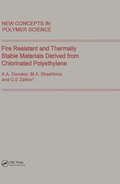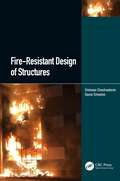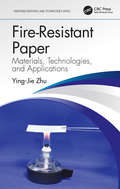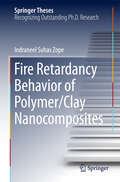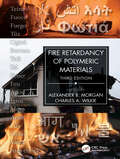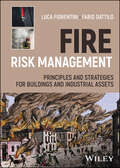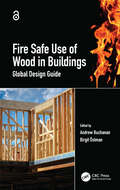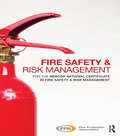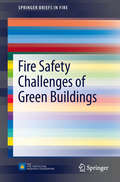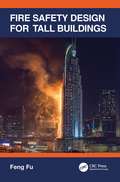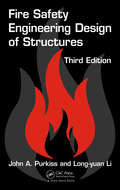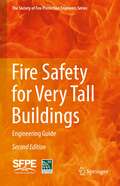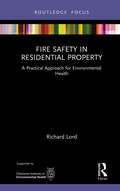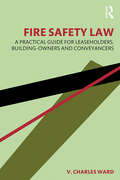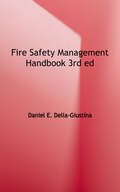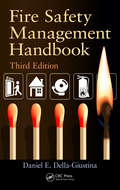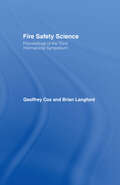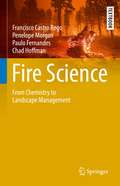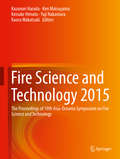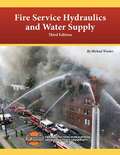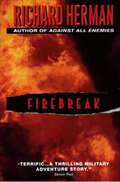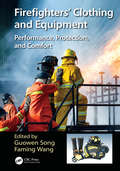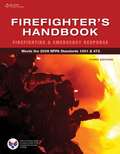- Table View
- List View
Fire Resistant and Thermally Stable Materials Derived from Chlorinated Polyethylene
by A. A. Donskoi M. A. Shashkina G. E ZaikovThis new volume in the book series New Concepts in Polymer Science focuses on the problem of creating materials with reduced combustibility as well as the use of polymeric materials for protection from fire or overheating. The majority of polymeric materials are combustible, which has led to the development of polymers, and materials based on these, with reduced combustibility. However the combustibility degree or their ability to protect from fire or high temperature can be indicated only in particular cases of combustion. In this volume the results of the development of physicochemical bases for creating organic polymeric materials with reduced combustibility, which are capable of protecting against high temperatures are discussed. A presentation of chlorinated polyolefins as organic polymers with reduced combustibility is also given.
Fire-Resistant Design of Structures
by Srinivasan Chandrasekaran Gaurav SrivastavaThis book addresses the detailed analysis and design of structures under fire loads through the basic concepts. While fire and explosion characteristics of materials are discussed in detail, an estimate of fire load and integration to fire-resistant design is the main focus. The detailed design procedures include practical examples of various design codes from around the world. The scope of Fire-Resistant Design of Structures includes discussions related to the estimate of fire loads, analysis and design of structural members under fire, fire protection and firefighting systems, working principles, and suitability for various industrial applications. It provides comprehensive coverage regarding the analysis and design of structural systems under fire loads, in particular, and under elevated temperatures, in general. Features: • Provides an understanding of fire loads, analysis, and design of various structural members • Includes detailed design methods and model studies • Covers in detail different types of firefighting equipment and their functions and applications
Fire-Resistant Paper: Materials, Technologies, and Applications (Emerging Materials and Technologies)
by Ying-Jie ZhuEven in today's electronic information age, traditional paper is a multi-purpose product that continues to be indispensable to people’s daily work and lives. While paper is a valued product, the paper industry contributes to environmental pollution and consumption of natural resources, and the organic substances out of which traditional paper is made render it highly flammable and easy to burn. This book introduces a new technology to develop environmentally friendly fire-resistant paper using highly flexible ultralong hydroxyapatite nanowires and discusses applications and potential for commercialization. Discusses characterization, properties, and synthesis of ultralong hydroxyapatite nanowires and compares them with cellulose fibers Describes steps to design and create fire-resistant paper Covers a variety of function-based fire-resistant paper, including antibacterial, magnetic, photoluminescent, among others Examines a host of applications, such as paper for anti-counterfeiting, encryption and decryption, environmental, energy, and biomedical uses Considers commercialization potential and future prospects This book is aimed at materials scientists, chemical engineers, industrial chemists, and other researchers from across the scientific and engineering disciplines interested in the development of this exciting alternative to traditional paper.
Fire Retardancy Behavior of Polymer/Clay Nanocomposites (Springer Theses)
by Indraneel Suhas ZopeThis thesis investigates the early ignition behavior of polymer/clay nanocomposites, which are perceived as potential eco-friendly flame retardant systems. It examines the correlation between clay structural chemistry and high-temperature transformations with clay-assisted decomposition of organic macromolecules. In particular, it investigates the unique effects of metal ions like Mg2+, Al3+ and Fe3+ that are inherent in clays (smectite) on the combustion and thermo-oxidative decomposition of polyamide 6. The results indicate that metal ions present on/in montmorillonite platelets have preferential reactivity towards peroxy/alkoxy groups during polyamide 6 thermal decomposition. Lastly, a simple solution in the form of a physical coating on clay surface is proposed, based on the role of polymer–clay interfacial interaction.
Fire Retardancy of Polymeric Materials
by Alexander B. Morgan Charles A. WilkieThe third edition of Fire Retardancy of Polymeric Materials provides a single source for all aspects of this highly challenging field of applied research. This authoritative book covers design and non-fire requirements that drive how these materials are fire protected.Detailed study and consideration of chemistry, physics, materials science, economic issues and fire safety science is necessary to address considerations of mechanical, thermal, environmental, and end-use requirements on top of fire protection means that the field requires. This thoroughly revised new edition continues to offer comprehensive coverage of the scientific approach for those developing fire safe materials. It covers new topics such as bio-based materials, regulatory issues, recycling, newer flame retardant chemical classes, and more details on how to flame retard materials for specific market applications.Written by a team of experts, this book covers the fundamentals of polymer burning and combustion and how to apply fire protection or flame-retardant chemistries to specific material classes and applications. The book is written for material scientists and fire safety scientists who seek to develop new fire safe materials or understand why materials burn in our modern environment.Features Connects fundamentals of material flammability to practical fire safety needs Covers current fire safety requirements and regulations affecting flame retardant selection Provides information on chemical structure-property relationships for flame retardancy Provides practical guidance on how to design fire safe materials for specific fire risk scenarios The new edition is expanded to 32 chapters and all chapters are updated and revised with the newest information
Fire Risk Management: Principles and Strategies for Buildings and Industrial Assets
by Luca Fiorentini Fabio DattiloFIRE RISK MANAGEMENT Practical methodologies to develop holistic and comprehensive fire safety strategies for buildings and industrial assets In Fire Risk Management: Principles and Strategies for Buildings and Industrial Assets, a team of distinguished authors delivers an incisive combination of risk management principles and fire safety assessment methods that offers practical strategies and workflows to prevent and mitigate today’s complex fire scenarios. The book summarizes modern, risk-based approaches to fire safety, discussing fire safety objectives in terms of functional statements, performance requirements, and detailed protection measures for buildings and industrial assets towards the development of a fire safety case to timely manage risk with a systematic and structured approach throughout the life cycle of the asset. The authors introduce the fundamentals of fire safety and design principles before moving on to discuss topics like fire risk assessment methods, risk profiles, risk mitigation, safety management and performance, and protective layers and controls. Fire Risk Management presents practical methods, often borrowed from those successfully used in other domains, that can be defined, shared, and communicated with multiple stakeholders from different backgrounds and with different needs and perspectives. Readers will also find: A code-neutral examination of fire safety principles that is independent of local regulations Discussions of key principle standards, including NFPA 550 and ISO 45001, and guidelines on fire risk assessment Practical explorations that connect theory with practice in the real world In-depth case studies that walk readers through fire risk management strategies for railway stations, warehouse storage facilities, heritage buildings, renewable energy installations, and process industry plants Perfect for fire safety practitioners, engineers, and other stakeholders involved in the design and operation of buildings and industrial assets, Fire Risk Management: Principles and Strategies for Buildings and Industrial Assets will also earn a place in the libraries of facility owners and operators, safety systems managers, occupational health and safety professionals, and code officials.
Fire Safe Use of Wood in Buildings: Global Design Guide
by Andrew Buchanan and Birgit ÖstmanThis book provides guidance on the design of timber buildings for fire safety, developed within the global network Fire Safe Use of Wood (FSUW) and with reference to Eurocode 5 and other international codes. It introduces the behaviour of fires in timber buildings and describes strategies for providing safety if unwanted fires occur. It provides guidance on building design to prevent any fires from spreading while maintaining the load-bearing capacity of structural timber elements, connections and compartmentation. Also included is information on the reaction-to-fire of wood products according to different classification systems, as well as active measures of fire protection, and quality of workmanship and inspection as means of fulfilling fire safety objectives. Presents global guidance on fire safety in timber buildings Provides a wide perspective, covering the whole field of fire safety design Uses the latest scientific knowledge, based on recent analytical and experimental research results Gives practical examples illustrating the importance of good detailing in building design Fire Safe Use of Wood in Buildings is ideal for all involved in the fire safety of buildings, including architects, engineers, firefighters, educators, regulatory authorities, insurance companies and professionals in the building industry.
Fire Safety and Risk Management: for the NEBOSH National Certificate in Fire Safety and Risk Management
by Fire Protection AssociationThis textbook is directly aligned to the NEBOSH National Certificate in Fire Safety and Risk Management, with each element of the syllabus explained in detail. Each chapter guides the student through the syllabus with references to legal frameworks and guidelines. Images, tables, case studies and key information are highlighted within the text to make learning more productive. Covering fire behaviour, safety, management, risk assessment, prevention and the changes to HSG65, the book can also be used as a daily reference by professionals. Written by experts in the field of fire safety Complete coverage that goes beyond the syllabus content making it a useful resource after study Illustrated throughout to enhance understanding
Fire Safety Challenges of Green Buildings
by Brian Meacham Brandon Poole Raymond Cheng Juan EcheverriaEnvironmental concerns and advances in architectural technologies have lead to a greater number of green buildings or buildings with green, eco-friendly elements. However, from a practical standpoint, there is no incident reporting system in the world that tracks data on fire incidents in green buildings. Fire safety objectives are not explicitly considered in most green rating schemes, and green design features have been associated with photovoltaic panels and roof materials, lightweight timber frame buildings, and combustible insulation materials. Fire Safety Challenges of Green Buildings is the result of an extensive global literature review that sought to identify issues related to green building elements or features and ways to ensure those issues are tracked for future improvement. The book identifies actual incidents of fires in green buildings or involving green building elements, points out issues with green building elements that would increase fire risk, clarifies reports and studies that address ways to reduce fire risk in green design elements, and compares research studies that explicitly incorporate fire safety into green building design. The authors also pinpoint gaps and specific research needs associated with understanding and addressing fire risk and hazards with green building design. Using their data, the authors developed a set of matrices relating these green attributes and potential fire hazards. With these comprehensive tools, potential mitigation strategies for addressing the relative increase in fire risk or hazard associated with the green building elements and features have been identified. Fire Safety Challenges of Green Buildings is intended for practitioners as a tool for analyzing building safety issues in green architecture and developing methods for tracking data related to green design elements and their potential hazards. Researchers working in a related field will also find the book valuable.
Fire Safety Design for Tall Buildings
by Feng FuFire Safety Design for Tall Buildings provides structural engineers, architects, and students systematic introductions to fire safety design for tall buildings based on current analysis methods, design guidelines, and codes. It covers almost all aspects of fire safety design that an engineer or an architect might encounter—such as performance-based design, the basic principles of fire development and heat transfer This book also sets out an effective way of preventing the progressive collapse of a building in fire, and it demonstrates 3D modeling techniques to perform structural fire analysis with examples that replicate real fire incidents such as Twin Towers and WTC7. This helps readers to understand the design of structures and analyze their behavior in fire.
Fire Safety Engineering Design of Structures
by John A. Purkiss Long-Yuan LiDesigning structures to withstand the effects of fire is challenging, and requires a series of complex design decisions. This third edition of Fire Safety Engineering Design of Structures provides practising fire safety engineers with the tools to design structures to withstand fires. This text details standard industry design decisions, and offers
Fire Safety for Very Tall Buildings: Engineering Guide (The Society of Fire Protection Engineers Series)
by International Code CouncilThis Guide provides information on special topics that affect the fire safety performance of very tall buildings, their occupants and first responders during a fire. This Guide addresses these topics as part of the overall building design process using performance-based fire protection engineering concepts as described in the SFPE Engineering Guide to Performance Based Fire Protection. This Guide is not intended to be a recommended practice or a document that is suitable for adoption as a code. The Guide pertains to “super tall,” “very tall” and “tall” buildings. Throughout this Guide, all such buildings are called “very tall buildings.” These buildings are characterized by heights that impose fire protection challenges; they require special attention beyond the protection features typically provided by traditional fire protection methods. This Guide does not establish a definition of buildings that fall within the scope of this document.
Fire Safety in Residential Property: A Practical Approach for Environmental Health (Routledge Focus on Environmental Health)
by Richard LordThis book aims to take the reader through all aspects of fire safety and management in residential settings, from origin and ignition, risk assessment, protection and prevention, as well as comparing effective enforcement options from across all parts of the UK. It outlines the basis of law, standards and guidance relating to fire safety and building performance, and critically evaluates the legal provisions and approaches to risk reduction with the focus on rented properties. This book: Provides wider access to fire safety knowledge previously generally used by regulators and specialists. Examines fire risk assessments in domestic premises and the competency of assessors. Explains the approaches to fire safety enforcement the impact of property licensing. Includes fire risk precautions for housing and general checklists to help landlords and tenants understand their responsibilities Explores the effect of existing legislation with references to key Property Tribunal decisions relating to fire risk management and future legal developments. This book will assist Environmental Health Officers and Environmental Health Practitioners – as well as graduating academics of the field – in their work to encourage the appropriate and effective use of legislation. Landlords, Estate managers, student accommodation managers, surveyors and tenant groups may also find this book of interest.
Fire Safety Law: A Practical Guide for Leaseholders, Building-Owners and Conveyancers
by V. Charles WardFire Safety Law provides building-owners, managers, individual leaseholders, mortgage-lenders, landlords, and anyone involved in the purchase or sale of a flat situated within a multi-occupied block, with practical, yet comprehensive and well-researched information regarding the subject of fire safety and the associated responsibilities, obligations and rights. V. Charles Ward addresses in practical legal terms the responsibilities on building-owners to ensure that buildings are fire-safe for people who are living, working, or visiting those buildings and explains what protections are available to leaseholders faced with the costs of making their buildings fire-safe. The book begins with a summary of the lessons which have come from the Grenfell Inquiry, before providing a practical overview of current fire-safety legislation relating to residential and commercial buildings. This legislative overview will include not only the 2005 Fire Safety Order, as updated by the 2021 Fire Safety Act and the Fire Safety (England) Regulations 2022, but will also include associated and emerging legislation and official guidance in relation to fire safety, including gas and electrical safety regulation, as well as the Building Safety Act 2022. The book will then pull apart a typical long-residential lease within a high-rise block to identify who is directly responsible for fire safety and explain how the costs of making good the fire-risk from defective cladding might be shared out between the ground-landlord and individual residential leaseholders. Having assessed the legal situation as regards existing high-rise leaseholders, the book then addresses the additional ‘due diligence’ required by prospective purchasers of individual high-rise flats, as well as estate agents, mortgage lenders, landlords and conveyancing lawyers, to ensure that what they will be buying or lending money on is ‘fire-safe’ and that any associated costs are fully accounted for.
Fire Safety Management Handbook
by Daniel E. Della-GiustinaSafety managers today are required to go beyond compliance with the latest fire codes to implement proactive fire safety management programs that improve profitability. By reducing property loss insurance premiums and fostering an efficient work environment to help realize quality gains, safety managers can add to the bottom line; however, they need a solid understanding of the duties and responsibilities for which they are accountable. <p><p>The Fire Safety Management Handbook is every safety manager's must-have guide for developing a successful fire safety management program. Emphasizing proactive fire safety activities that achieve optimal results, the text presents the key elements that comprise an effective fire safety management program, including a basic knowledge of: <p>- Types and functions of fire control equipment <p>- Identification and control of hazardous materials <p>- Homeland security during disasters and emergencies <p>- Fire chemistry, building construction, and efforts to reduce losses due to fire <p>- Commonly installed fire detection systems and their maintenance and inspection <p>- National Fire Codes (NFPA) and federal, state, and local legislation and enforcement <p>- Available resources, fire safety organizations, and the United States Fire Administration (USFA) <p><p>To provide current and future safety professionals with a better understanding of emergency management within the fire safety discipline, each chapter of the Third Edition includes learning objectives at the beginning and questions at the end. Case studies have been added, codes and standards have been updated, and a new chapter on emergency response planning has been included. Plus, a school fire safety plan that can be used as a template is now part of the appendices.
Fire Safety Management Handbook
by Daniel E. Della-GiustinaA must-have guide for current and future safety professionals, the third edition of this practical handbook presents the key elements of an effective fire safety management program; explains the types and functions of fire control equipment; discusses the identification and control of hazardous materials; identifies safety organizations and available resources for fire service programs; describes commonly installed fire detection systems and their maintenance and inspection; and includes learning objectives, case studies, updated codes and standards, and information about emergency response and school fire safety planning.
Fire Safety (Merit Badge Series)
by Boy Scouts of AmericaDetailed requirements for earning a merit badge in fire safety.
Fire Safety Science
by Geoffrey Cox Brian LangfordThis book provides an essential reference on the current state of the art in this field covering topics as diverse as physics, chemistry, toxicology and human behaviour. It contains nearly one hundred scientific papers on all aspects of the subject. Many papers are included which illustrate the current state of development in the mathematical modelling of fire phenomena using computing.
Fire Science: From Chemistry to Landscape Management (Springer Textbooks in Earth Sciences, Geography and Environment)
by Francisco Castro Rego Penelope Morgan Paulo Fernandes Chad HoffmanThis textbook provides students and academics with a conceptual understanding of fire behavior and fire effects on people and ecosystems to support effective integrated fire management. Through case studies, interactive spreadsheets programmed with equations and graphics, and clear explanations, the book provides undergraduate, graduate, and professional readers with a straightforward learning path. The authors draw from years of experience in successfully teaching fundamental concepts and applications, synthesizing cutting-edge science, and applying lessons learned from fire practitioners. We discuss fire as part of environmental and human health. Our process-based, comprehensive, and quantitative approach encompasses combustion and heat transfer, and fire effects on people, plants, soils, and animals in forest, grassland, and woodland ecosystems from around the Earth. Case studies and examples link fundamental concepts to local, landscape, and global fire implications, including social-ecological systems. Globally, fire science and integrated fire management have made major strides in the last few decades. Society faces numerous fire-related challenges, including the increasing occurrence of large fires that threaten people and property, smoke that poses a health hazard, and lengthening fire seasons worldwide. Fires are useful to suppress fires, conserve wildlife and habitat, enhance livestock grazing, manage fuels, and in ecological restoration. Understanding fire science is critical to forecasting the implication of global change for fires and their effects. Increasing the positive effects of fire (fuels reduction, enhanced habitat for many plants and animals, ecosystem services increased) while reducing the negative impacts of fires (loss of human lives, smoke and carbon emissions that threaten health, etc.) is part of making fires good servants rather than bad masters.
Fire Science and Technology 2015
by Kazunori Harada Ken Matsuyama Keisuke Himoto Yuji Nakamura Kaoru WakatsukiThisbook focuses on topics in the entire spectrum of fire safety science, targetingresearch in fires, explosions, combustion science, heat transfer, fluiddynamics, risk analysis, structural engineering, and other subjects. The bookcontributes to a gain in advanced scientific knowledge and presents or advancesnew ideas in all topics in fire safety science. Two decades ago, the 1stAsia-Oceania Symposium on Fire Science and Technology was held in Hefei, China. Since then, the Asia-Oceania Symposia have grown in size and quality. Thisbook, reflecting that growth, helps readers to understand fire safetytechnology, design, and methodology in diverse areas including historicalbuildings, photovoltaic panels, batteries, and electric vehicles.
Fire Service Hydraulics and Water Supply
by Michael A. WiederThe ability to identify a sufficient water supply source and use it effectively to control a fire is one of the most basic functions of the fire service. <p><p>This text includes information on the basics of water and water flow, theoretical and practical methods of determining water flow and pressure loss, types of pumps and fire apparatus used to move water, relay pumping operations, fire pump testing, and effectively supplying sprinkler and standpipe systems. <p><p>In addition to new, up-to-date photos and graphics, this 3rd edition discusses recent research on updating friction loss coefficients for modern fire hose. This is also the first edition of this text that includes information and calculations using the Metric System of measurement, where applicable. <p><p>While the intent of the text was meant to address the needs of the higher education market, many fire departments have chosen to use the text for their driver/operator training and promotional testing needs. The information takes the user to a more advanced level of skill and understanding in operating their apparatus than standard driver/operator manuals. <p><p>This text was written to meet all of the National Fire Academy’s FESHE model course curriculum objectives for Fire Protection Hydraulics and Water Supply (C0277) course at the Associate’s Degree level. Some requirements from NFPA 1002, Fire Apparatus Driver/Operator Professional Qualifications (2017 edition) are addressed throughout various portions of the text. <p><p>There are separate units for the chapters that have both U.S. and metric versions. The files are designed so that they may be easily customized to meet local program needs.
Fire Service Hydraulics and Water Supply
by Michael A. WiederThe ability to identify a sufficient water supply source and use it effectively to control a fire is one of the most basic functions of the fire service. This text includes information on the basics of water and water flow, theoretical and practical methods of determining water flow and pressure loss, types of pumps and fire apparatus used to move water, relay pumping operations, fire pump testing, and effectively supplying sprinkler and standpipe systems. <p><p>In addition to new, up-to-date photos and graphics, this 3rd edition discusses recent research on updating friction loss coefficients for modern fire hose. This is also the first edition of this text that includes information and calculations using the Metric System of measurement, where applicable. While the intent of the text was meant to address the needs of the higher education market, many fire departments have chosen to use the text for their driver/operator training and promotional testing needs. The information takes the user to a more advanced level of skill and understanding in operating their apparatus than standard driver/operator manuals. <p><p>This text was written to meet all of the National Fire Academy’s FESHE model course curriculum objectives for Fire Protection Hydraulics and Water Supply (C0277) course at the Associate’s Degree level. Some requirements from NFPA 1002, Fire Apparatus Driver/Operator Professional Qualifications (2017 edition) are addressed throughout various portions of the text. There are separate units for the chapters that have both U.S. and metric versions. The files are designed so that they may be easily customized to meet local program needs.
Firebreak
by Richard HermanThe “master of the techno-thriller” moves from the oval office to the frontlines as war erupts in the Middle East in this “fast-paced novel” (Publishers Weekly).In the wake of the Gulf War, a madman still holds the reins of power in Iraq. When his call for a Holy War unites the Arab world against Israel, the resulting combat is certain to have Earth-shattering implications. Israel stands ready to unleash its nuclear arsenal, and it’s up to American President Zack Pontowski to deescalate the situation. As military and geopolitical forces reach a fever pitch, the only chance to avoid Armageddon is to take out Iraq’s chemical weapons arsenal. Pontowski dispatches the 45th Tactical Fighter Wing—a squadron led by his own grandson—to execute the mission.
Firefighters' Clothing and Equipment: Performance, Protection, and Comfort
by Guowen Song Faming WangProtective clothing and equipment used for firefighters protect them against their harsh working environment loaded with strong thermal hazards, elevated environmental temperatures, low oxygen concentration and smoke. This book describes an in-depth review of firefighting clothing and equipment, and explicitly addresses the performance of protection and comfort in textile engineering, clothing design, and evaluation. Covered topics include protection and comfort requirements for firefighting clothing and equipment, testing methods, standards and performance evaluation, smart firefighting clothing for first responders and numerical modeling of performance of firefighting clothing. Key Features Presents complete overview about the requirements of firefighters' protective clothing/thermal protective materials Addresses performance of protection and comfort Includes human thermoregulation system and responses to firefighting working environment Discusses SMART firefighting clothing and equipment Suggests "how to improve the wear comfort?
Firefighter's Handbook: Firefighting and Emergency Response
by Cengage Learning DelmarNIMAC-sourced textbook
